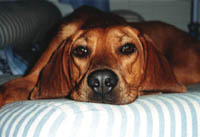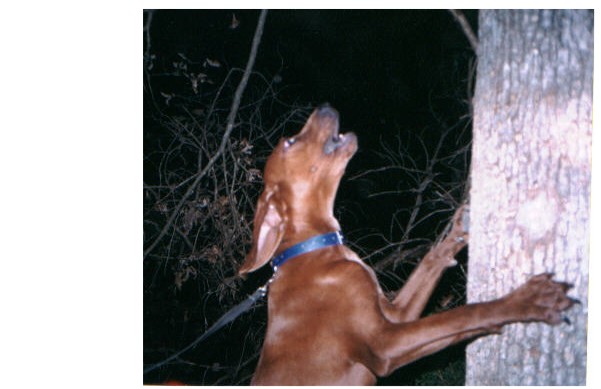![]()
Redbone
HISTORY
Years ago most coon hunters who owned a red dog of unknown ancestry, but proven ability in tracking and treeing raccoons, called his dog a "Redbone". Then a few serious breeders who were devoted both to the breed and the sport began a campaign of selective breeding to produce a hound with the necessary characteristics to make a superior coonhound and which would breed true to type in color and conformation.
The foundation stock of the modern day Redbone came from George F. L. Birdsong of Georgia, who was a noted foxhunter and breeder. He obtained the pack of Dr. Thomas Henry in the 1840's.
As is the case with most of the other coonhound breeds, the ancestors of the Redbone were foxhounds. A Bloodhound cross is said to have been made, and it's also said that the blood of the Irish hounds was also introduced later. This latter cross is said to account for the white chest and feet markings which still occasionally show up in Redbone pups today.
The first dogs were commonly called "Saddlebacks". The background color was red, and most of them possessed black saddle markings. By selective breeding, the black saddle was bred out and the solid red dogs became known as Redbone Coonhounds.
The Redbone was the second coonhound breed to be registered with U. K. C., the first being registered in 1902, two years after the American Black & Tan.
Of the six coonhound breeds, the Redbone is probably the most uniform as to type and size. The breed is distinguished by a medium build, pleading eyes and a"sweet" voice. The rich, deep red color makes the Redbone a striking dog to look at.
The Redbone is known to be a well-balanced breed, making them adaptable to various types of hunting and terrain. Their agility benefits them when hunting in fenced country or steep, rocky ground. Redbones are known to make excellent water dogs.
COLOR
Solid red preferred, small amount of white on brisket or feet not objectionable.
HEAD
EARS: Set moderately low, fine in texture, not stiff, and reaching near the end of the not when stretched out. Ears in proportion to head. Fault: Ears not firmly attached to head, seemingly just to skin.
EYES: Brown to hazel in color, dark eyes preferred. Set well apart and of pleading expression.
SKULL: Moderately broad, well proportioned with body.
MUZZLE: Well balanced with other features of head, never dished or upturned.
TEETH: Scissors bite preferred, even bite acceptable.
NECK
Throat clean, medium in length, strong, slightly arched and held erect denoting proudness. Slight fold of skin below angle of jaw not objectionable.
SIZE
Slightly taller at shoulder than at hips. Never opposite. Males: 22 to 27 inches. Females: 21 to 25 inches.
BODY
Deep broad chest. Back strong and slightly arched; length well-proportioned to height. Thighs and shoulders up, clean and muscular. Well-sprung ribs, plenty of lung space.
TAIL
Medium in length, very slight brush.
LEGS
Legs straight, well boned, pasterns straight, well set, clean and muscular denoting combination of both strength and speed. Never cow hocked.
FEET
Cat-paw type, compact, well-padded, toes strong and well arched, stout, well set nails. Feet should set as directly under leg as possible